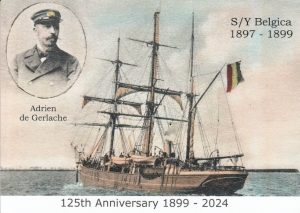 The Belgian Antarctic Expedition of 1897–1899 was the first expedition to winter in the Antarctic region. Led by Adrien de Gerlache de Gomery, it was the first Belgian Antarctic expedition and is considered the first expedition of the Heroic Age of Antarctic Exploration. Among its members were Frederick Cook and Roald Amundsen, explorers who would later attempt the respective conquests of the North and South Poles.
The Belgian Antarctic Expedition of 1897–1899 was the first expedition to winter in the Antarctic region. Led by Adrien de Gerlache de Gomery, it was the first Belgian Antarctic expedition and is considered the first expedition of the Heroic Age of Antarctic Exploration. Among its members were Frederick Cook and Roald Amundsen, explorers who would later attempt the respective conquests of the North and South Poles.
To celebrate the 125th Anniversary of the return of S/Y Belgica to Antwerp (5 november 1899) a special post card and stamps have been issued.
TNX Dr. Eddy de Busschere of the Belgian Polar Expedition Society for sending us one of this special card.
 S/Y Belgica did remain trapped in the ice for a long Antarctic winter.
S/Y Belgica did remain trapped in the ice for a long Antarctic winter.
The crew disliked the penguin and seal meat that had been stored and initially tried to ban its consumption, but Signs of scurvy began to show in some of the men. Gerlache and Captain Lecointe became so ill they wrote their wills. Two of the crew started to show signs of mental illness and morale in general was extremely poor. Lieutenant Danco fell ill from a heart condition and died on 5 June. Danco Island was named in his honor.
Cook and Amundsen took command as Gerlache and Lecointe were unable to fulfill their roles due to scurvy. The true cause of scurvy as a deficiency of Vitamin C was not discovered until the 1920s, but Cook was convinced that raw meat was a possible cure for scurvy due to his experiences with Robert Peary in the Arctic. He retrieved the frozen penguin and seal meat and insisted that each man eat some each day. Even Gerlache began to eat the meat and slowly the men recovered their health. It is now known that raw meat and organs contain a small amount of Vitamin C.
Several months of hardship followed. Even as spring and summer arrived, attempts to free the ship and its crew from the grip of the ice failed. By January 1899, Belgica was still trapped in ice about seven feet (2.1 m) thick and the possibility of another winter in the ice seemed real. Open water was visible about half a mile away and Cook suggested that trenches be cut to the open water to allow Belgica to escape the ice. The weakened crew used the explosive “tonite” and various tools to create the channel. Finally, on 15 February 1899, they managed to start slowly down the channel they had cleared during the weeks before. It took them nearly a month to cover seven miles (11 km), and on 14 March, they cleared the ice. The expedition returned to Antwerp on 5 November 1899. Though the circumstances were severe, the expedition had nevertheless managed to collect scientific data, including a full year of meteorological observations.
